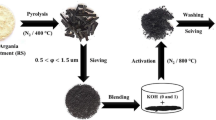Abstract
An activated carbon membrane to be used in water treatments was developed and the decolorization of the coke furnace wastewater was successfully demonstrated as a model case. The activated carbon membrane was prepared by carbonizing poly-vinydenchloride (PVdC) and poly-vinylalcohol (PVA) microspheres aggregating on and within a ceramic pipe. The membrane developed in this work was suspected to have a bidispersed structure, which made it possible to play the roles of both a porous membrane having the molecular weight cut-off of about 10,000 and an activated carbon bed where the dissolved organics with low molecular weight could be adsorbed. The activated carbon membrane developed in this work appears to be useful for compact water treatment processes.
Similar content being viewed by others
References
Dollimore, D. and G.R. Heal,J. Appl. Chem.,14, 109 (1964).
Hatori, H. et al.,Carbon,30, 719–720 (1992).
Horvath, G. and K. Kawazoe,J. Chem. Eng. Japan,16, 470 (1983).
Kawashima, H. and M. Suzuki,Kogyo Yosui (in Japanese), No. 334, 9 (1986).
Koresh, J.E. and A. Soffer,Sep. Sci. Tech.,22, 973–982 (1987).
Rao, M.B. and S. Sircar,J. Membrane Sci.,85, 253–264 (1993).
Author information
Authors and Affiliations
Rights and permissions
About this article
Cite this article
Sakoda, A., Nomura, T. & Suzuki, M. Activated carbon membrane for water treatments: Application to decolorization of coke furnace wastewater. Adsorption 3, 93–98 (1997). https://doi.org/10.1007/BF01133010
Issue Date:
DOI: https://doi.org/10.1007/BF01133010




